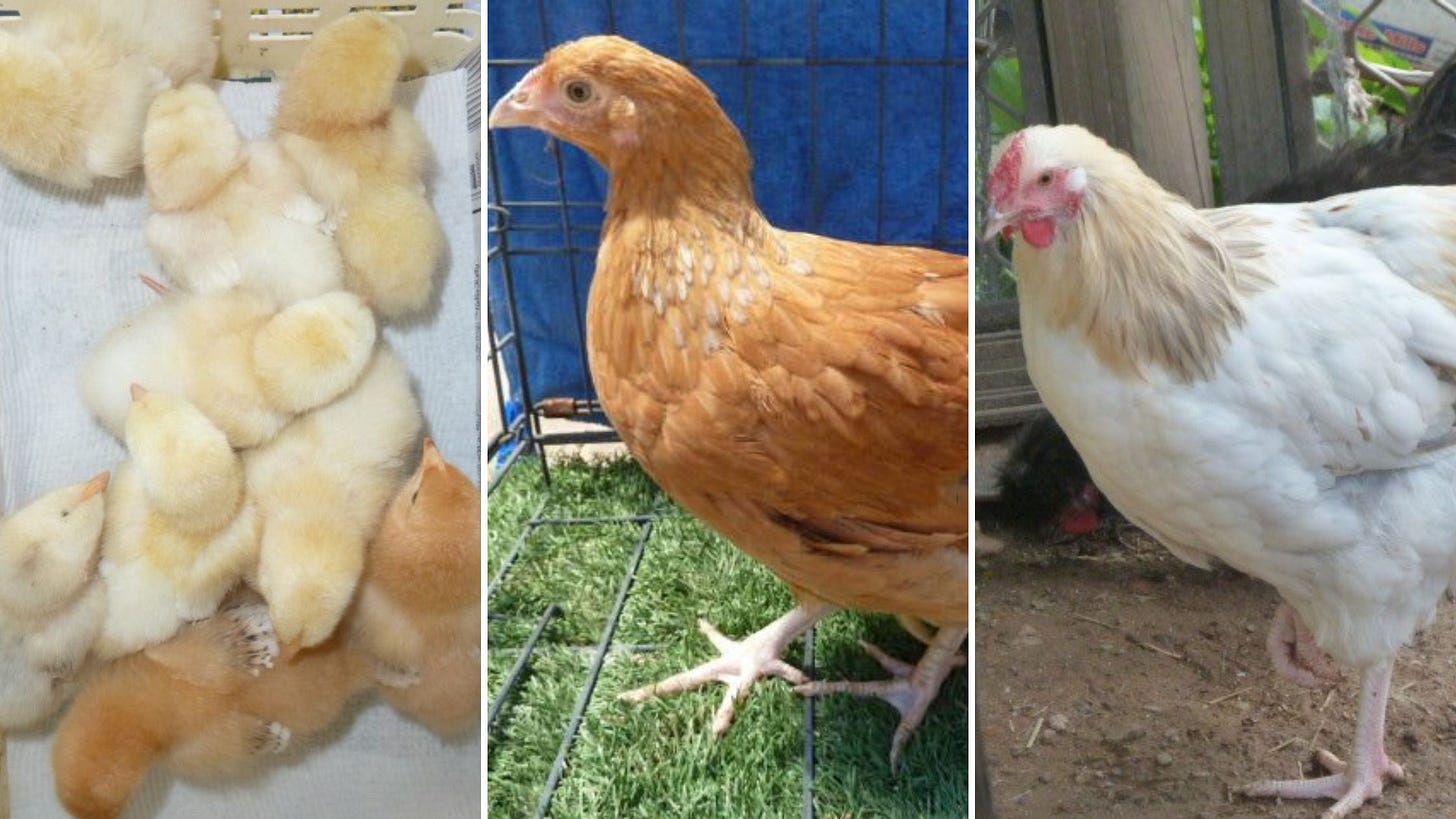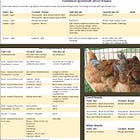Sex-linked breeding in poultry - Part 2
Why understanding Gold, Silver, and Barred is important in sex-linked breedings
This is Part 2 of the mega-article on Sex-linked breeding in poultry.
The other parts are:
Part 2: Gold, Silver, Barred (this article)
And also see my article on Autosexing poultry breeds.
Note that due to the vagaries of Substack, which doesn’t have the ability to create tables, any tables are created them as downloadable PDFs. The table images are linked to the PDF so you can download and print them for your own use; click on the image to open the PDF.
If you find them useful and wish to share, please reference them back to this Substack article: I’ve spent a lot of time on these!
Sex-linking - gold, silver, and barred
These are probably the most common sex-linked crosses. There are genetic reasons for why they work reliably, and I don’t actually understand them at all, because chicken genetics isn’t something I’ve concentrated on to this point.
Suffice to say, then, that for Gold/Silver/Barred sex-linkage to work, it requires EITHER:
a purebreed “gold" male (rooster or cockerel) over (ie mated with) a purebreed “silver” female (pullet or hen) OR
a purebreed solid-coloured male (rooster or cockerel) over (ie mated with) a purebreed barred female (pullet or hen)
Note:
It doesn't work the other way around.
The parent birds must be pure breeds, as crossbreeds will have too many other genetics kicking around to produce a reliable result.
It doesn’t work if you then try to breed the offspring from this first (F1) cross.
It works once, and once only - a “terminal” cross. In this sense, “terminal” doesn’t mean “fatal”; it means “the identifying characteristics won’t carry through to future generations”.
The result is chicks that have different-coloured down as soon as they fluff up from hatching.
Broadly:
gold male over silver female gives buff/gold/brown female chicks and white/yellow/silvery male chicks
gold or solid male over barred female gives plain black female chicks and black-with-white -head-spot male chicks.
See also:
Contents
Lists of suitable breeds and colours
Barred crossings
Gold over Silver crossings
What is silver, gold, and barred?
It has to do with genetics, and the underlying genetic makeup of the bird. I will admit this isn’t my area of expertise, and will try to cover it in a separate article - once I’ve consulted with experts and got a handle on it myself …
In general:
“Gold” tends to be expressed in birds with brown/red colourings. Rhode Island Red is a classic example.
“Silver” tends to turn up in birds with at least some white colourings. Light Sussex is a classic example.
Barring, also called cuckoo, refers to birds with grey-and-white stripes. Plymouth Rock is the classic example, and tends to be most commonly used in sex-linked breedings. It’s also a core component of the “recipe” for autosexing breeds.
Autosexing and sex-linking
“Autosexing” and “sex-linked” are two terms that broadly mean the same thing. They’re used in breeding, to refer to chicks where you can accurately and reliably identify the sex of the chick as soon as it’s hatched and the down has fluffed up. Autosexing
Gold, silver, and barred can be breed-specific, or they can relate to colours within breeds.
Some breeds can have gold, silver, solid, and/or barred patterns within the one breed; where this is the case, mating a gold or solid male of one colour to a silver or barred female of another colour will produce sex-linked purebreed chicks.
Note, however, that while the the offspring will be pure breeds:
They’re not autosexing, because it requires two different colours within the same breed to work, and the characteristics won’t carry through with the offspring.
Gold/silver crosses are unlikely to be to the Standard for the relevant breed, and the adults might have some broken or messy feather colours and patterns.
Black/barred crosses, however, use the same Extended Black gene, so for breeds where both barred/cuckoo and black are accepted colours, it is possible to conduct a sexlinked cross between them and still end up with correctly coloured offspring. For example, see these pictures of black Leghorn rooster over cuckoo Leghorn hen.
It isn’t as simple as saying “this chook is brown and that one is white, so their offspring will be sex-linked”. It needs to be the right kind of “gold” and “silver”, “plain” and “barred”.
However, any purebreed hen or pullet with cuckoo/barred feather patterns should produce sex-link offspring if mated to a gold or solid-coloured purebreed cockerel or rooster.
The genetic explanation: Gold and Silver basics
Explanation thanks to Kaitlin Bryant
There are two types of pigment in chickens - eumelanin (black) and pheomelanin (red/gold).
All gold and silver birds have a gold base colour. What changes is the presence of the Dominant Silver S gene or matching allele non-silver s+. Silver is a modifying gene that turns gold feathers white. S/s+ sit on the W chromosome.
Unlike humans that are XX female/XY male, chickens are ZW female/ZZ male.
Therefore, a female Silver bird can only carry one copy of the Silver gene on her Z chromosome, and she must pass it on to all her sons.
The genetic explanation: barring
Explanation thanks to Kaitlin Bryant
Unlike humans that are XX female/XY male, chickens are ZW female/ZZ male.
The barring gene is Dominant and sits on the Z chromosome.
Hens being ZW only have 1 copy of barring gene, and they have to give that Z chromosome to their sons, therefore all male offspring must be barred.
All cockerel chicks hatch with a white spot on their head to indicate that barring.
The pullet chicks receive one Z chromosome from their father which is non-barred, and the W chromosome from their mother, meaning they end up non-barred.
Lists of suitable breeds and colours
Barred crossings
Any solid-colour purebreed male except for white over any purebreed barred/cuckoo female.
Solid-colour means the male must be the same colour all over, save for maybe some glossy black sheen in tail and, maybe, wing feathers.
So Rhode Island Red rooster is fine, with their beetle-green highlights in the tail and wings; Light Sussex rooster, however, with the columbian pattern, is not. Any Australorp male will work except splash.
Why not white?
From Poultry Keeper:
It all comes down to the fact white chickens can be any number of genetic combinations beneath the white plumage. They could carry blue, barring, dominant white (the type required for pile), silver, gold, columbian, lacing, and the list goes on. The ‘white feathered’ fowl sat before you could have the genetic base of any variety of poultry you can think of … However, the only ‘true’ way to test what a white birds carries is to cross a coloured bird to it and monitor the results.
Breeds that have barred or cuckoo patterns include the following.
Araucana
Cochin
Dorking
Gamebirds
Jap bantam
Leghorn
Marans
Orpington
Pekin
Plymouth Rock
Polish
Scots Grey
Transylvanian Naked Neck
Wyandotte
List taken from the Open Poultry Standards. Only breeds that I know exist in Australia are listed.
Note that for breeds where the cuckoo patterning may have been recently re-created in Australian birds, the results may be inconsistent. This may include Marans and Araucana.
Gold over Silver crossings
Any of the “genetically gold” purebreed cockerels crossed with any one of the “genetically silver” purebreed females should result in Buff/Red/Brown pullets and Silver/White/Grey cockerels.
This works for crossing different breeds, and crosses within breeds.
Note that crossing gold and silver colours within breeds will result in a sex-linked purebreed bird, but the colour/pattern produced will not be to Standard and the bird is generally unsuitable for showing or for future use in breeding to Standard.
In particular, crossing patterns within breeds such as Wyandottes or Hamburgh will create broken or very messy lacing, which can be very difficult to breed back to a standardised colour or pattern - if that were your aim.
Table adapted from two sources:
Poultry Keeper: Sex-Linked Crosses and their Offspring
Open Poultry Standards search for “buff” and “chocolate” as accepted colours within breeds.
This is not an absolutely complete list, but it’s fairly comprehensive.
Want more? Read the other articles in this series:
Part 2: Gold, Silver, Barred (this article)





